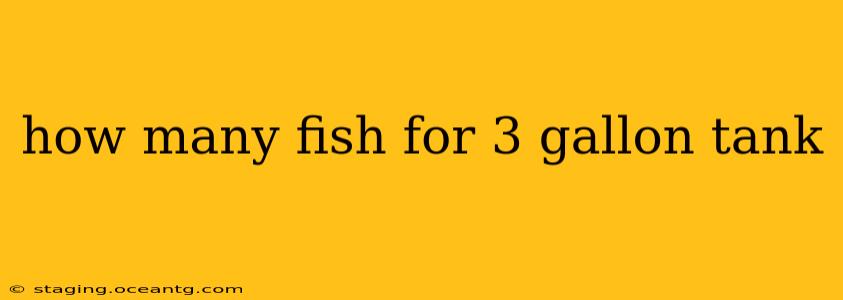How Many Fish for a 3-Gallon Tank? The Truth About Tiny Tanks
A 3-gallon tank is undeniably cute, but the question of how many fish it can hold is crucial for the well-being of the aquatic inhabitants. The short answer is: very few, if any. While some sources might suggest a betta or a few small shrimp, the reality is that even one fish in a 3-gallon tank is pushing it, especially for the long term.
Let's delve deeper into the factors that determine appropriate fish stocking:
What are the limitations of a 3-gallon tank?
A 3-gallon tank presents several limitations that significantly restrict the number of fish it can support:
-
Limited Water Volume: The smaller the tank, the faster water parameters can change. Waste products build up rapidly, impacting water quality and stressing the fish. Maintaining stable water chemistry becomes exponentially more challenging in a small tank.
-
Restricted Space: Fish, even small ones, need space to swim, explore, and exhibit natural behaviors. Cramped conditions lead to stress, aggression, and disease.
-
Filtration Capacity: Efficient filtration is vital for maintaining water quality. Finding a filter suitable for a 3-gallon tank that effectively manages waste without disrupting the delicate balance of the ecosystem can be difficult. Overstocking further strains the filter's capacity.
-
Temperature Stability: Smaller volumes of water are more susceptible to temperature fluctuations, causing additional stress on the inhabitants.
Can I keep a betta fish in a 3-gallon tank?
This is a frequently debated topic. While some claim bettas can thrive in 3-gallon tanks, especially with meticulous maintenance, it's generally not recommended. Even with diligent water changes and excellent filtration, the limited space and risk of rapid water quality deterioration outweigh the benefits. A larger tank, at least 5 gallons, is much more suitable for a betta.
What about shrimp or snails?
Small invertebrates like shrimp and snails are often suggested for 3-gallon tanks. They generally produce less waste than fish, making them seemingly suitable for a smaller environment. However, even with these, diligent monitoring of water parameters is critical to avoid ammonia spikes and ensure their health. Overstocking with even invertebrates can still lead to problems.
How many fish in a 3-gallon tank: Considering other factors
Beyond the tank size, the following influence how many fish (if any) you can responsibly keep:
-
Fish Species: Different fish species have different space requirements and waste production rates. Some are more tolerant of smaller environments than others.
-
Filtration System: A high-quality filter is essential, even in small tanks, to keep the water clean.
-
Maintenance Schedule: Frequent water changes are absolutely necessary in a 3-gallon tank to prevent the buildup of harmful substances.
The best choice for a small space:
Instead of focusing on squeezing fish into a tiny tank, consider alternative options for enjoying aquatic life in a small space. A planted nano tank focusing on aquatic plants and invertebrates, or a larger tank, offers a far more enriching and ethical environment for any aquatic life.
In conclusion, aiming for a healthy aquatic environment should always prioritize the well-being of the animals. A 3-gallon tank is simply too small to provide the necessary space and water quality for most fish. While some small invertebrates might be considered with extremely careful management, it's crucial to prioritize responsible pet ownership over aesthetics.
